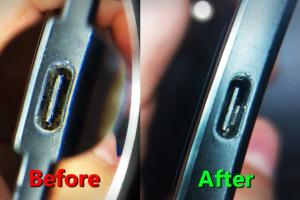Ultimate Guide: How to Clean a USB-C Charging Port Safely and Effectively

-
Quick Links:
- Introduction
- Why Clean Your USB-C Port?
- Common Issues with Dirty USB-C Ports
- Tools and Materials You’ll Need
- Step-by-Step Guide to Cleaning Your USB-C Port
- Expert Insights and Tips
- Case Studies and Real-World Examples
- Preventive Measures for USB-C Port Maintenance
- FAQs
Introduction
USB-C ports have become the standard for charging and data transfer in modern electronic devices. However, these ports are prone to collecting dust, lint, and other debris over time, which can hinder their performance. This guide will help you understand the importance of cleaning your USB-C charging port, the steps to do it safely, and tips for maintaining it in the future.
Why Clean Your USB-C Port?
Cleaning your USB-C port is crucial for several reasons:
- Improved Connectivity: Dirt and debris can prevent a proper connection between your charger and device.
- Device Longevity: Regular cleaning can extend the life of your device and its charging components.
- Prevent Charging Failures: A dirty port can lead to intermittent charging or complete failure to charge.
Common Issues with Dirty USB-C Ports
Here are some common problems you might encounter with a dirty USB-C port:
- Slow charging speeds
- Device overheating while charging
- Warning messages about incompatible accessories
- Inability to connect to other devices via USB-C
Tools and Materials You’ll Need
Before diving into the cleaning process, gather the following tools and materials:
- Compressed air canister
- Soft-bristled brush or toothbrush
- Isopropyl alcohol (70% or higher)
- Cotton swabs
- Microfiber cloth
- Anti-static wrist strap (optional)
Step-by-Step Guide to Cleaning Your USB-C Port
Follow these steps to clean your USB-C charging port effectively:
Step 1: Power Off Your Device
Before cleaning, ensure your device is powered off to avoid any short circuits.
Step 2: Inspect the Port
Use a flashlight to look inside the USB-C port. Identify any visible dust or debris.
Step 3: Use Compressed Air
Hold the canister upright and gently spray air into the port to dislodge dust. Keep the nozzle a few inches away from the port.
Step 4: Brush Away Debris
Using a soft-bristled brush, gently scrub around the edges of the port. Avoid using too much force.
Step 5: Clean with Isopropyl Alcohol
Dampen a cotton swab with isopropyl alcohol and carefully clean the inside of the port. Be cautious not to leave any fibers behind.
Step 6: Wipe Down the Exterior
Use a microfiber cloth to clean the exterior of the port and the surrounding area.
Step 7: Allow to Dry
Let the port dry completely before turning your device back on.
Expert Insights and Tips
Experts recommend cleaning your USB-C port every few months, especially if you frequently use it. Additionally, consider using a port cover to prevent dust buildup.
Case Studies and Real-World Examples
Many users have reported significant improvements in charging efficiency after cleaning their USB-C ports. For instance, a user experienced a 50% increase in charging speed following a thorough cleaning, illustrating the impact of regular maintenance.
Preventive Measures for USB-C Port Maintenance
- Use a protective case that covers the port when not in use.
- Avoid charging in dusty environments.
- Regularly inspect the port as part of your device maintenance routine.
FAQs
1. How often should I clean my USB-C port?
It is advisable to clean your USB-C port every few months or whenever you notice charging issues.
2. What tools do I need to clean a USB-C port?
You will need compressed air, a soft brush, isopropyl alcohol, cotton swabs, and a microfiber cloth.
3. Can I use a toothpick to clean the port?
While it is possible, it is not recommended as it may damage the internal components of the port.
4. What should I do if my device still won't charge after cleaning?
If cleaning does not resolve the issue, consider consulting a professional technician as there may be deeper hardware issues.
5. Is it safe to use compressed air?
Yes, as long as you use it correctly. Keep the canister upright and at a safe distance from the port to avoid moisture.
6. Can I clean my USB-C port while the device is on?
No, always turn off your device before cleaning to prevent damage or short circuits.
7. How can I prevent dust from entering my USB-C port?
Using a dust cover or keeping your device in a clean environment can help prevent dust accumulation.
8. What are the signs that my USB-C port needs cleaning?
Signs include slow charging, overheating, or connection issues with accessories.
9. Is isopropyl alcohol safe for cleaning electronic ports?
Yes, isopropyl alcohol is safe for electronics as it evaporates quickly and does not leave residue.
10. Can I clean my USB-C port with water?
No, water can cause short circuits and damage your device. Always use dry cleaning methods.
By following this comprehensive guide, you can ensure that your USB-C charging port remains clean and functions optimally. Regular maintenance will not only enhance your device's performance but also prolong its lifespan.